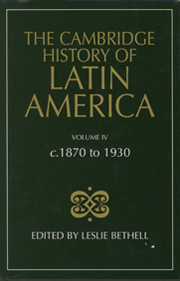Book contents
- Frontmatter
- 1 Latin America and the international economy, 1870–1914
- 2 Latin America and the international economy from the First World War to the World Depression
- 3 Latin America, The United States and the European powers, 1830–1930
- 4 The population of Latin America, 1850–1930
- 5 Rural Spanish America, 1870–1930
- 6 Plantation economies and societies in the Spanish Caribbean, 1860–1930
- 7 The growth of Latin American cities, 1870–1930
- 8 Industry in Latin America before 1930
- 9 The urban working class and early Latin American labour movements, 1880–1930
- 10 Political and social ideas in Latin America, 1870–1930
- 11 The literature, music and art of Latin America, 1870–1930
- 12 The Catholic Church in Latin America, 1830–1930
- Bibliographical essays
- Index
- References
8 - Industry in Latin America before 1930
Published online by Cambridge University Press: 28 March 2008
- Frontmatter
- 1 Latin America and the international economy, 1870–1914
- 2 Latin America and the international economy from the First World War to the World Depression
- 3 Latin America, The United States and the European powers, 1830–1930
- 4 The population of Latin America, 1850–1930
- 5 Rural Spanish America, 1870–1930
- 6 Plantation economies and societies in the Spanish Caribbean, 1860–1930
- 7 The growth of Latin American cities, 1870–1930
- 8 Industry in Latin America before 1930
- 9 The urban working class and early Latin American labour movements, 1880–1930
- 10 Political and social ideas in Latin America, 1870–1930
- 11 The literature, music and art of Latin America, 1870–1930
- 12 The Catholic Church in Latin America, 1830–1930
- Bibliographical essays
- Index
- References
Summary
Introduction
The attainment of a modern society founded upon a developed economy has been an enduring objective in Latin America, exercising the minds of pensadores and policymakers intermittently since the revolutions for independence at the beginning of the nineteenth century. The promotion of manufacturing activities was regarded as central to the realization of that objective. Various views as to the most appropriate means of stimulating industrial expansion prevailed: options included direct state aid for manufacturing and a more generalized encouragement of economic growth that would promote individual initiative in the industrial sector alongside investment in other activities. Frequent contemporary recourse to the word industria (often employed in a context where modern usage would require the expression ‘industrialization’) is evidence of the importance attached to it and possibly the perception of a failure to develop a manufacturing base – at least during the period before 1930.
It used to be argued by historians of Latin America that industrialization only became feasible after the depression of the 1930s, that is, after a period of profound economic crisis in the central, industrialized capitalist economies. The world economic crisis and associated reduction in international trade had a profound impact upon the foreign trade sector of the republics and undermined a peculiar socio-institutional order committed to a political economy rooted in economic internationalism. Principally associated with authors writing from a dependency perspective, the view was advanced that adverse externally induced dislocation facilitated industrialization in Latin America. The collapse of the inport–export complex removed an anti-industry bias in Latin American societies as the political dominance of a landed and commercial oligarchy was challenged by a rising industrial bourgeoisie and (in a few cases) an incipient urban industrial proletariat.
- Type
- Chapter
- Information
- The Cambridge History of Latin America , pp. 267 - 324Publisher: Cambridge University PressPrint publication year: 1986

